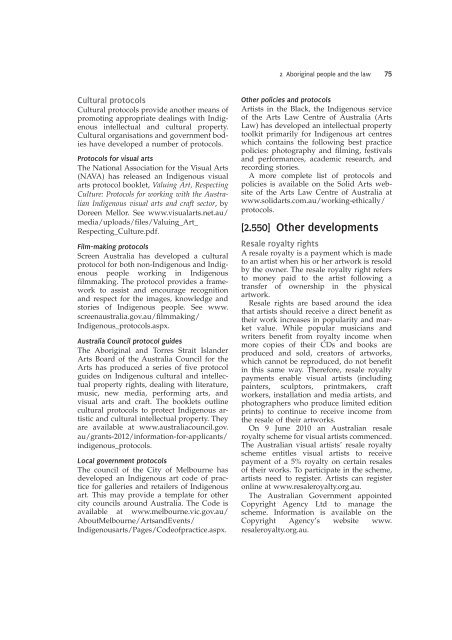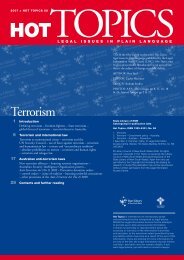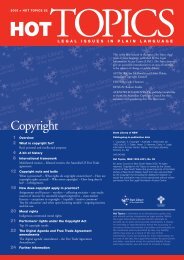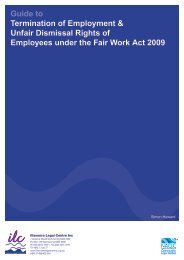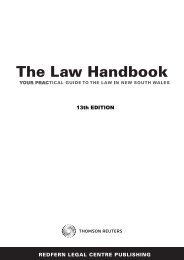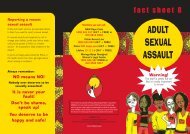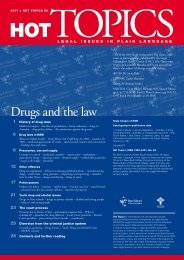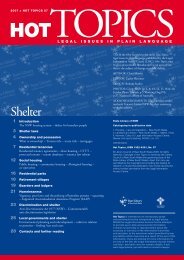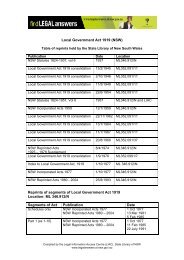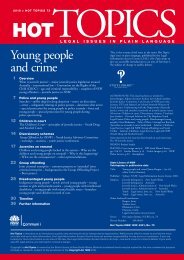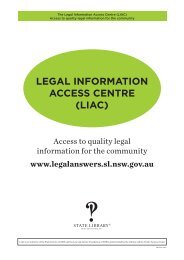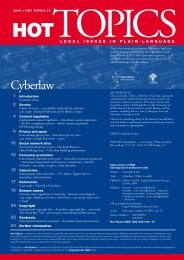Aboriginal people and the law - Legal Information Access Centre
Aboriginal people and the law - Legal Information Access Centre
Aboriginal people and the law - Legal Information Access Centre
Create successful ePaper yourself
Turn your PDF publications into a flip-book with our unique Google optimized e-Paper software.
2 <strong>Aboriginal</strong> <strong>people</strong> <strong>and</strong> <strong>the</strong> <strong>law</strong> 75Cultural protocolsCultural protocols provide ano<strong>the</strong>r means ofpromoting appropriate dealings with Indigenousintellectual <strong>and</strong> cultural property.Cultural organisations <strong>and</strong> government bodieshave developed a number of protocols.Protocols for visual artsThe National Association for <strong>the</strong> Visual Arts(NAVA) has released an Indigenous visualarts protocol booklet, Valuing Art, RespectingCulture: Protocols for working with <strong>the</strong> AustralianIndigenous visual arts <strong>and</strong> craft sector, byDoreen Mellor. See www.visualarts.net.au/media/uploads/files/Valuing_Art_Respecting_Culture.pdf.Film-making protocolsScreen Australia has developed a culturalprotocol for both non-Indigenous <strong>and</strong> Indigenous<strong>people</strong> working in Indigenousfilmmaking. The protocol provides a frameworkto assist <strong>and</strong> encourage recognition<strong>and</strong> respect for <strong>the</strong> images, knowledge <strong>and</strong>stories of Indigenous <strong>people</strong>. See www.screenaustralia.gov.au/filmmaking/Indigenous_protocols.aspx.Australia Council protocol guidesThe <strong>Aboriginal</strong> <strong>and</strong> Torres Strait Isl<strong>and</strong>erArts Board of <strong>the</strong> Australia Council for <strong>the</strong>Arts has produced a series of five protocolguides on Indigenous cultural <strong>and</strong> intellectualproperty rights, dealing with literature,music, new media, performing arts, <strong>and</strong>visual arts <strong>and</strong> craft. The booklets outlinecultural protocols to protect Indigenous artistic<strong>and</strong> cultural intellectual property. Theyare available at www.australiacouncil.gov.au/grants-2012/information-for-applicants/indigenous_protocols.Local government protocolsThe council of <strong>the</strong> City of Melbourne hasdeveloped an Indigenous art code of practicefor galleries <strong>and</strong> retailers of Indigenousart. This may provide a template for o<strong>the</strong>rcity councils around Australia. The Code isavailable at www.melbourne.vic.gov.au/AboutMelbourne/Arts<strong>and</strong>Events/Indigenousarts/Pages/Codeofpractice.aspx.O<strong>the</strong>r policies <strong>and</strong> protocolsArtists in <strong>the</strong> Black, <strong>the</strong> Indigenous serviceof <strong>the</strong> Arts Law <strong>Centre</strong> of Australia (ArtsLaw) has developed an intellectual propertytoolkit primarily for Indigenous art centreswhich contains <strong>the</strong> following best practicepolicies: photography <strong>and</strong> filming, festivals<strong>and</strong> performances, academic research, <strong>and</strong>recording stories.A more complete list of protocols <strong>and</strong>policies is available on <strong>the</strong> Solid Arts websiteof <strong>the</strong> Arts Law <strong>Centre</strong> of Australia atwww.solidarts.com.au/working-ethically/protocols.[2.550] O<strong>the</strong>r developmentsResale royalty rightsA resale royalty is a payment which is madeto an artist when his or her artwork is resoldby <strong>the</strong> owner. The resale royalty right refersto money paid to <strong>the</strong> artist following atransfer of ownership in <strong>the</strong> physicalartwork.Resale rights are based around <strong>the</strong> ideathat artists should receive a direct benefit as<strong>the</strong>ir work increases in popularity <strong>and</strong> marketvalue. While popular musicians <strong>and</strong>writers benefit from royalty income whenmore copies of <strong>the</strong>ir CDs <strong>and</strong> books areproduced <strong>and</strong> sold, creators of artworks,which cannot be reproduced, do not benefitin this same way. Therefore, resale royaltypayments enable visual artists (includingpainters, sculptors, printmakers, craftworkers, installation <strong>and</strong> media artists, <strong>and</strong>photographers who produce limited editionprints) to continue to receive income from<strong>the</strong> resale of <strong>the</strong>ir artworks.On 9 June 2010 an Australian resaleroyalty scheme for visual artists commenced.The Australian visual artists’ resale royaltyscheme entitles visual artists to receivepayment of a 5% royalty on certain resalesof <strong>the</strong>ir works. To participate in <strong>the</strong> scheme,artists need to register. Artists can registeronline at www.resaleroyalty.org.au.The Australian Government appointedCopyright Agency Ltd to manage <strong>the</strong>scheme. <strong>Information</strong> is available on <strong>the</strong>Copyright Agency’s website www.resaleroyalty.org.au.


